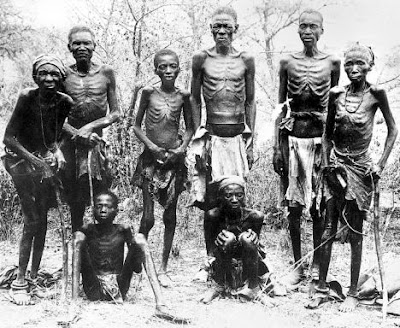Lebensraum
The term lebensraum was coined by Friedrich Ratzel
This distorted view of lebensraum set the stage for the first genocide
From the outset, the Germans demonstrated a sense of entitlement to the land and its resources and frequently confiscated native land, parceling them out to German settlers. By 1903 the Herero
The Herero tribes were exploited,brutally oppressed and murdered. German reinforcements were brought in from Berlin to crush the resistance with military force. General Trotha, who was appointed Supreme Commander of the colony, had this to say about the Herero: "I believe that the nation as such should be annihilated, or, if this was not possible by tactical measures, have to be expelled from the country..." In the Battle of Waterberg
A German scientist, Eugen Fischer was brought in to conduct medical experiments on the African prisoners, subjecting them to sterilization and injections of smallpox, typhus, and tuberculosis. Extensive racial tests were conducted to measure the features and appearance of the Herero, and they were classified as racially inferior. These and other German tactics had the preliminary earmarks of what was to become the Final Solution during WWII.
By 1914, and in the midst of WWI, Berlin had already prepared a proposal which stipulated postwar peace terms. Convinced that victory was within their reach, the Germans anticipated annexing part of Poland, followed by the deportation of the Polish and Lithuanian population and settlement of Germans in their stead. (German historian Andreas Hillgruber maintains that this policy was the forerunner to the German policy of annexation and deportation of WWII.)
Contrary to popular belief, lebensraum was not coined by Hitler though he expounded on its theory at great length in his book Mein Kampf
In 1939-040, a secret Nazi plan, called Generalplan Ost
Polish 80-85%
Belorusians 75%
Ukrainians 65%
Lithuanians 85%
Latvians 50%
Estonians 50%
Czechs 50%
Latgalians 100% (ethnic Latvians of Latgale)
Moreover the Nazis established varying percentages for different peoples to undergo "Germanization"; Czechs (50%), Ukrainians (35%), Belarusians (25%). According to their Plan, the Nazis intended to exterminate, expulse, Germanize, or enslave the Slavs in conquered territories.
In the "Big Plan", to be put in effect after the war, the Nazis envisaged the deportation from eastern occupied territories of 45 million "non-Germanizable" people, that is, people considered by the Nazis to be "racially undesirable", such as 100% of Jews, Poles (85%), Belorusians (75%), Ukrainians (65%) and to deport them to Siberia. The Nazi plan was to allow 14 million prisoners to remain, and serve as slave labor to the 8 to 10 millions of German settlers, who were to fulfill the Nazi vision of lebensraum and populate Eastern Europe. Latvian, Lithuania and Estonia would be Germanized within 20-25 years.
In 1941, the Nazis deliberated on the procedure for the complete destruction of Poland, to occur within 10 to 20 years, that is, they envisaged the Polish nation as devoid of ethnic Poles and settled entirely by German colonists. The destruction of Poland began in September 1939 with the deportation of Polish intelligentsia, bans on Polish culture, Polish education, and even speaking in Polish. The Nazis expected that deportations of Poles to Siberia would guarantee their assimilation and eventual extinction as a nation. Their 1952 projections estimated that roughly 3-4 million non-Germanized Poles would remain. Those who refused to be Germanized would be prohibited to marry or receive medical help when needed. Children who could be Germanized were forcibly taken from their parents and deported and resettled with German families.
Several policies outlined in Generalplan Ost were implemented by the Nazis during the war: Operation Tannenberg(1939): code name for one of the extermination actions directed at the Poles. Before the outbreak of war, the Nazis, with the assistance of the Volksdeutsche, compiled a list of 61,000 Polish intelligentsia, who were to be either interned or shot: A-B Aktion (1940): the Nazi plan to eliminate Polish elite, intellectuals and upper classes, (leaders, professors, teachers, scientists, and many others) Over 30,000 were arrested. About 7,000 were massacred in Palmiry Forest, and the remainder interned in German concentration camps. Einsatzgruppen death squads and concentration camps were organized to deal with the Polish elite. Parts of Poland were annexed to Germany quite early in the war, and with the exception of eastern Poland, the remaining territory was under Nazi General Gouvernement.
It could not be confirmed whether the Generalplan Ost had any connection to the Nazi crimes against humanity and the "Final Solution" of the Jews. Documents were destroyed by the Nazis at the end of the war. The only evidence remaining were memoranda and letters referring to the Generalplan Ost.
But during the Nuremberg Trials, Adolf Eichmann, the SS officer placed in charge of logistics by General Reinhard Heydrich, admitted responsibility for the deportation of 500,000 Poles.
One hundred years after the Herero genocide, on August 14, 2004, German Minister Heidemarie Wiedzorek-Zeu attended a commemorative ceremony in Namibia. In her speech to the audience she acknowledged that the action taken by the Germany army against the uprising was in fact a genocide. She added that the German government would not provide compensation to the victims' descendants, but would continue the economic aid already in place to the tune of $14m a year. A group of Herero had filed a claim against Germany in the US, for $ 4 billion in compensation.
Nothing that the German Minister said amounted to an apology, and following her speech the crowd demanded an apology. Her response: "Everything I said in my speech was an apology..."
Sources:
Wikipedia: Lebensraum, Generalplan Ost, Ostsiedlung, Herero and Namaqua Genocide,
Hitler's Plans for Eastern Europe
Lebensraum, schatzie! Lebensraum!
Propaganda Posters
Germany admits Namibia genocide
Lebensraum, schatzie! Lebensraum!
Propaganda Posters
Germany admits Namibia genocide
Suggested Links:
Poland Under Nazi Terror (Polish Greatness.com)



You got a nice blog
ReplyDelete